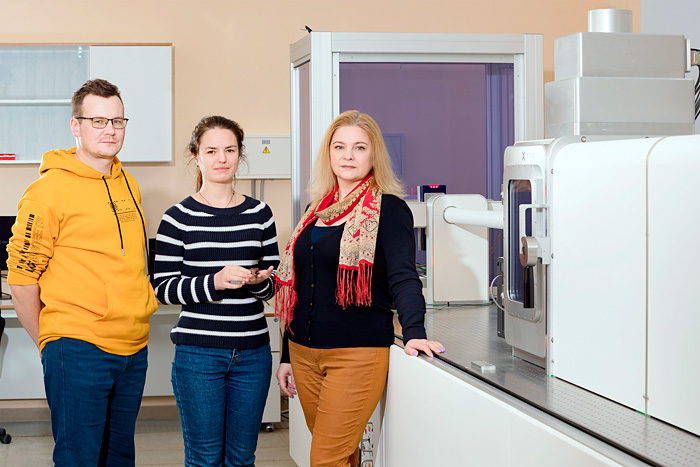
Electronic english version since 2022 |
The newspaper was founded in November 1957
| |
New Facility Expands the Possibilities for Researchers
The report "Biohybrid Nanocomplexes and Their Potential Application in Biomedicine" by FLNP employee Yu.E.Gorshkova presented at the 131st session of the JINR Scientific Council aroused great interest among its participants. For details, I contacted Group No.3 of the Scientific and Experimental Department of Neutron Investigations of Condensed Matter of FLNP.
- In May 2021, a new device appeared at the Frank Laboratory of Neutron Physics - USAXS/SAXS/WAXS Xeuss 3.0 X-ray scattering station (XENOXS, France), - began the talk Yu.E.Gorshkova. - This acquisition made it possible, first of all, to "unload" the YuMO small-angle neutron scattering facility at the IBR-2 high-flux pulsed reactor. Out of 14 facilities included in the IBR-2 User Programme at JINR FLNP, the YuMO spectrometer accounts for about 30 percent of the total number of applications for the experiment, and the available beam time is significantly less than requested. Secondly, the complementarity of neutron and X-ray scattering allows one not only to obtain additional information about the materials under study, but also to conduct independent interdisciplinary research in the fields of condensed matter physics, materials science, chemistry, biology, geophysics, pharmacology, medicine, nuclear physics, ecology, and others.
Today, it is the only operating device of this class in Russia. The presence of an ultra-small-angle mode (USAXS) makes it possible to study the internal structure and shape of materials down to micron scales, which significantly expands the characteristic small-angle range from ~ 1 to 250 nm. Using wide-angle X-ray scattering (WAXS), one can obtain information about the crystal structure of a sample at the atomic level.
- We are engaged in one of the priority areas of research of the team of the Scientific and Experimental Department of Neutron Investigations of Condensed Matter of JINR FLNP, which is also implemented at the X-ray facility within the framework of the scientific theme "Investigations of Functional Materials and Nanosystems Using Neutron Scattering", - O.N.Lis continued the conversation. - Progress in the development of modern technologies is directly connected with the search and creation of new functional materials that demonstrate unique physical properties. Over the past decades, the main technological advances have been achieved due to the discovery of new physical phenomena in materials, including high-temperature superconductivity, the colossal magnetoresistance effect, the dielectric-metal transition, charge and orbital ordering, ferroelectricity, the magnetoelectric effect, and others. Many of these phenomena have already formed the basis for the development of various advanced technologies, for example, in the fields of recording and storage of data, various fields of electronics and spintronics, communications, energetics, while others have potentially important technological applications. In comparison with other experimental methods, the application of high pressure is a direct method for controlling changes in physical properties by means of variation of interatomic distances and angles, molecular conformations, or energy balance between different competing interactions. Therefore, one of the important scientific directions implemented by our team under the guidance of Denis Petrovich Kozlenko, Doctor of Physical and Mathematical Sciences, is structural investigations at high pressures. Our scientific interests are related to the description of the structural aspect in the formation of physical phenomena observed in complex magnetic materials with a strong correlation of different degrees of freedom - spin, orbital, charge, and lattice. One of the most promising approaches consists in changing thermodynamic parameters - high external pressure and temperature. Such an approach makes it possible to determine the microscopic mechanisms of changes in physical properties. In particular, the structural and magnetic properties of materials can undergo strong changes when exposed to high pressure as a result of phase transitions.

Photo by Elena Puzynina: Senior engineer E.V.Lukin, graduate student O.N.Lis,
senior researcher Yu.E.Gorshkova
Our team at the Laboratory of Neutron Physics has more than twenty years of experience in the development of neutron scattering methods at high pressure. We have elaborated a whole range of experimental methods for conducting unique experiments at high pressures: special neutron diffractometers DN-6 and DN-12 operate on the basis of the IBR-2 high-flux pulsed reactor. Recently, a new experimental capability for conducting high-pressure experiments, namely the Xeuss 3.0 X-ray diffractometer, has emerged. This device allows studying the crystal structure of materials in high-pressure chambers with diamond anvils, which can generate pressures up to 50 GPa, or half a million atmospheres. Among the results of our recent investigations are structural phase transitions in molecular crystals, ferroelectrics, multiferroics, low-dimensional magnets, and others. As a graduate student, I am studying geometrically frustrated magnetic materials - low-dimensional van der Waals magnets, magnetic analogues of graphene. We have recently discovered the existence of a new structural modification of FePS3 with a monoclinic crystal structure at high pressure.
- At present, the facility is in high demand among the staff of our Laboratory and colleagues from various scientific centres of Russia, - Yu.E.Gorshkova said in conclusion. - We actively continue to work with our long-term partners, develop new areas of cooperation, including with the companies of SEZ "Dubna".
Olga Tarantina